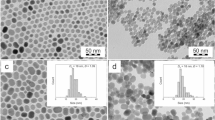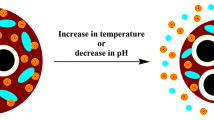Abstract
In biological applications of nanoparticles, the control of physicochemical properties such as size, shape, and surface charge enables the improvement of their ability for cancer target. In addition, it can be tracked by labeling in these nanoparticles with medical radionuclides for detection of cancer. Here, we report novel chelator-free direct-labeling of hierarchical hematite nanoclusters with 89Zr (89Zr-IONCs) through hydrothermal reaction to develop biocompatible radiolabeled nanoparticle which is effective for tracking cancer cells. Characterization of 89Zr-IONCs revealed that the zirconium ions were tightly bound inside hematite crystals with intervals of glutamic acid absorbed on their surfaces having spindle shape with a mean width of 180 nm and length of 80 nm. This method showed promising radiolabeling yield and labeling stability in biological environments which was ≥ 99%. Their high colloidal stability in serum was considerably maintained for the span of a week by the formation of protein corona with the hematite nanoclusters. For the result of biological evaluations, cytotoxicity assay provides evidence of the high biocompatibility of the product. The elevated in vitro cellular uptake of 89Zr-IONCs for the CT-26 and A549 cells was observed. Furthermore, we found that the spindle shape of 89Zr-IONCs was more effective for cell internalization compared with round shape due to the extended interfacial surface area with a cell membrane when their endocytosis is started. Our one-pot synthesized 89Zr-incorporated hematite nanoclusters show the promising approach for a simple and highly stable chelator-free radiolabeling system, which exploits the non-toxic potential carrier to target cancer cells.









Similar content being viewed by others
References
Ai F, Ferreira CA, Chen F, Cai W (2016) Engineering of radiolabeled iron oxide nanoparticles for dual-modality imaging. Wiley Interdiscip Rev Nanomed Nanobiotechnol 8:619–630
Albanese A, Tang PS, Chan WCW (2012) The effect of nanoparticle size, shape, and surface chemistry on biological systems. Annu Rev Biomed Eng 14:1–16
Ardelean IL, Stoencea LBN, Ficai D, Ficai A, Trusca R, Vasile BS, Nechifor G, Andronescu E (2017) Development of stabilized magnetite nanoparticles for medical applications. J Nanomater 2017:1–9
Boros E, Bowen AM, Josephson L, Vasdev N, Holland JP (2015) Chelate-free metal ion binding and heat-induced radiolabeling of iron oxide nanoparticles. Chem Sci 6:225–236
Chen H et al (2014) Iron-loaded magnetic nanocapsules for pH-triggered drug release and MRI imaging. Chem Mater 26:2105–2112
Chen F, Goel S, Valdovinos HF, Luo H, Hernandez R, Barnhart TE, Cai W (2015) In vivo integrity and biological fate of chelator-free zirconium-89-labeled mesoporous silica nanoparticles. ACS Nano 9:7950–7959
Chen D et al (2017) In vivo targeting and positron emission tomography imaging of tumor with intrinsically radioactive metal-organic frameworks nanomaterials. ACS Nano 11:4315–4327
Deri MA, Zeglis BM, Francesconi LC, Lewis JS (2013) PET imaging with 89 Zr: from radiochemistry to the clinic. Nucl Med Biol 40:3–14
Fischer G, Seibold U, Schirrmacher R, Wängler B, Wängler C (2013) Zr, a Radiometal nuclide with high potential for molecular imaging with PET: chemistry, applications and remaining challenges. Molecules 18(6):6469–6490
Henderson MC, Hollingsworth AB, Gordon K, Silver M, Mulpuri R, Letsios E (2016) Integration of serum protein biomarker and tumor associated autoantibody expression data increases the ability of a blood-based proteomic assay to identify breast cancer. PLoS One 11(8):e0157692
Holland JP, Sheh Y, Lewis JS (2009) Standardized methods for the production of high specific-activity zirconium-89. Nucl Med Biol 36:729–739
Honary S, Zahir F (2013) Effect of zeta potential on the properties of nano-drug delivery systems-a review (Part 1). Trop J Pharm Res 12:255–264
Hoshyar N, Gray S, Han H, Bao G (2016) The effect of nanoparticle size on in vivo pharmacokinetics and cellular interaction. Nanomedicine 11:673–692
Huang C, Zhang Y, Yuan H, Gao H, Zhang S (2013) Role of nanoparticle geometry in endocytosis: laying down to stand up. Nano Lett 13:4546–4550
Jin Q et al (2017) Ultra-small iron-gallic acid coordination polymer nanoparticles for chelator-free labeling of 64Cu and multimodal imaging-guided photothermal therapy. Nanoscale 9:12609–12617
Kandori K, Sakai M, Inoue S, Ishikawa T (2006) Effects of amino acids on the formation of hematite particles in a forced hydrolysis reaction. J Colloid Interface Sci 239(1):108–115
Khalil M, Yu J, Liu N, Lee RL (2014) Hydrothermal synthesis, characterization, and growth mechanism of hematite nanoparticles. J Nanopart Res 16:2362–2372
Kobayashi H, Watanabe R, Choyke PL (2014) Improving conventional enhanced permeability and retention (EPR) effects; what is the appropriate target? Theranostics 4:81
Kunjachan S, Ehling J, Storm G, Kiessling F, Lammers T (2015) Noninvasive imaging of nanomedicines and nanotheranostics: principles, progress, and prospects. Chem Rev 115:10907–10937
Kumar V, Neha S, Maitra SS (2017) In vitro and in vivo toxicity assessment of nanoparticles. International Nano Letters 7(4):243–256
Kuppusamy P, Govindan N, Yusoff MM, Ichwan SJA (2017) Proteins are potent biomarkers to detect colon cancer progression. Saudi J Biol Sci 24:1212–1221
Lee JY, Vyas CK, Kim GG, Choi PS, Hur MG, Yang SD, Kong YB, Lee EJ, Park JH (2019) Red blood cell membrane bioengineered Zr-89 labelled hollow mesoporous silica nanosphere for overcoming phagocytosis. Sci Rep 9:7419
Lewis MR, Kannan R (2014) Development and applications of radioactive nanoparticles for imaging of biological systems. Wiley Interdiscip Rev Nanomed Nanobiotechnol 6:628–640
Li S-D, Huang L (2009) Nanoparticles evading the reticuloendothelial system: role of the supported bilayer. Biochim Biophys Acta 1788:2259–2266
Liu T et al (2015) Iron oxide decorated MoS2 nanosheets with double PEGylation for chelator-free radiolabeling and multimodal imaging guided photothermal therapy. ACS Nano 9:950–960
Li N, Zilin Yu, Truc Pham, Philip Blower, Ran Yan, (2017) A generic Zr labeling method to quantify the in vivo pharmacokinetics of liposomal nanoparticles with positron emission tomography. Int J Nanomedicine 12:3281–3294
Longmire M, Choyke PL, Kobayashi H (2008) Clearance properties of nano-sized particles and molecules as imaging agents: considerations and caveats. Nanomedicine (London) 3:703–717
Merlot AM, Kalinowski DS, Richardson DR (2014) Unraveling the mysteries of serum albumin—more than just a serum protein. Front Physiol 5:299
Mitra S, Das S, Mandal K, Chaudhuri S (2007) Synthesis of a α-Fe2O3 nanocrystal in its different morphological attributes: growth mechanism, optical and magnetic properties. Nanotechnology 18:275608
Moore TL, Rodriguez-Lorenzo L, Hirsch V, Balog S, Urban D, Jud C, Rothen-Rutishauser B, Lattuada M, Petri-Fink A (2015) Nanoparticle colloidal stability in cell culture media and impact on cellular interactions. Chem Soc Rev 44(17):6287–6305
Nakamura Y, Mochida A, Choyke PL, Kobayashi H (2016) Nanodrug delivery: is the enhanced permeability and retention effect sufficient for curing cancer? Bioconjug Chem 27:2225–2238
O’Brien MN, Jones MR, Mirkin CAJPNAS (2016) The nature and implications of uniformity in the hierarchical organization of nanomaterials. PANS 113:11717–11725
Pellico J, Ruiz-Cabello J, Saiz-Alia M, Rosaria GD, Caja S, Montoya M, Manuel LF, Morales MP, Gutierrez L, Galiana B, Enriquez J, Herranz F (2016) Fast synthesis and bioconjugation of Ga core-doped extremely small iron oxide nanoparticles for PET/MR imaging. Contrast Media & Molecule imaging 11:203–210
Prabhakar U et al (2013) Challenges and key considerations of the enhanced permeability and retention effect for nanomedicine drug delivery in oncology. Cancer Res 73:2412–2417
Rhim W-K, Kim M, Hartman KL, Kang KW, Nam J-M (2015) Radionuclide-labeled nanostructures for in vivo imaging of cancer. Nano Convergence 2:10
Schwaminger SP, García PF, Merck GK, Bodensteiner FA, Heissler S, Günther S, Berensmeier S (2015) Nature of interactions of amino acids with bare magnetite nanoparticles. J Phys Chem C 119(40):23032–23041
Shang L, Nienhaus K, Nienhaus GU (2014) Engineered nanoparticles interacting with cells: size matters. J Nanobiotechnol 12:5
Shaffer TM, Matthew A, Wall SH, Longo VA, Drain CM, Kircher MF, Grimm J (2015) Silica nanoparticles as substrates for Chelator-free labeling of Oxophilic radioisotopes. Nano Lett 15(2):864–868
Shin S, Song I, Um S (2015) Role of physicochemical properties in nanoparticle toxicity. Nanomaterials 5(3):1351–1365
Smith BR, Gambhir SS (2017) Nanomaterials for in vivo imaging. Chem Rev 117(3):901–986
Sun X, Cai W, Chen X (2015) Positron emission tomography imaging using radiolabeled inorganic nanomaterials. Acc Chem Res 48:286–294
Tan W-F, Yu Y-T, Wang M-X, Liu F, Koopal LK, JCG, Design (2013) Shape evolution synthesis of monodisperse spherical, ellipsoidal, and elongated hematite (α-Fe2O3) nanoparticles using ascorbic acid. Cryst Growth Des 14:157–164
Toy R, Peiris PM, Ghaghada KB, Karathanasis E (2014) Shaping cancer nanomedicine: the effect of particle shape on the in vivo journey of nanoparticles. Nanomedicine (London) 9:121–134
Wall MA et al (2017) Chelator-free radiolabeling of SERRS nanoparticles for whole-body PET and intraoperative Raman imaging. Theranostics 7:3068
Wang J, Zhu W, Liu L, Chen Y, Wang C (2015) Synthesis and cellular internalization of spindle hematite/polymer hybrid nanoparticles. ACS Appl Mater Interfaces 7:5454–5461
Wong RM, Dustin A, Gilbert KL, Louie AY (2012) Rapid size-controlled synthesis of dextran-coated, cu-doped Iron oxide nanoparticles. ACS Nano 6(4):3461–3467
Wu W, Wu Z, Yu T, Jiang C, Kim W-S (2015) Recent progress on magnetic iron oxide nanoparticles: synthesis, surface functional strategies and biomedical applications. Sci Technol Adv Mater 16:023501
Wu W, Xiao X, Zhang S, Zhou J, Fan L, Ren F, Jiang C (2010) Large-scale and controlled synthesis of Iron oxide magnetic short nanotubes: shape evolution, growth mechanism, and magnetic properties. J Phys Chem C 114(39):16092–16103
Zeglis BM, Houghton JL, Evans MJ, Viola-Villegas N, Lewis JS (2013) Underscoring the influence of inorganic chemistry on nuclear imaging with Radiometals. Inorg Chem 53(4):1880–1899
Zeng C, Chen Y, Kirschbaum K, Lambright KJ, Jin RJS (2016) Emergence of hierarchical structural complexities in nanoparticles and their assembly. Science 354:1580–1584
Zhang Y-N, Poon W, Tavares AJ, McGilvray ID, Chan WCW (2016) Nanoparticle-liver interactions: cellular uptake and hepatobiliary elimination. J Control Release 240:332–348
Zhao Y et al (2017) A comparison between sphere and rod nanoparticles regarding their in vivo biological behavior and pharmacokinetics. Sci Rep 7:4131
Funding
This research was supported by the Nuclear R&D Program through the National Research Foundation of Korea funded by the Ministry of Science, ICT, and Future planning (2017M2A2A6A05016600, 2017R1D1A1B03035589, and 2018M2A2B3A02071348), and Dongguk University Research Fund of 2019.
Author information
Authors and Affiliations
Corresponding authors
Ethics declarations
Conflict of interest
The authors declare that they have no conflict of interest.
Additional information
Publisher’s note
Springer Nature remains neutral with regard to jurisdictional claims in published maps and institutional affiliations.
Electronic supplementary material
ESM 1
(DOCX 2653 kb)
Rights and permissions
About this article
Cite this article
Choi, P.S., Lee, J.Y., Vyas, C.K. et al. One-pot synthesis of chelator-free 89Zr-incorporated hierarchical hematite nanoclusters for in vitro evaluation. J Nanopart Res 21, 240 (2019). https://doi.org/10.1007/s11051-019-4680-5
Received:
Accepted:
Published:
DOI: https://doi.org/10.1007/s11051-019-4680-5




